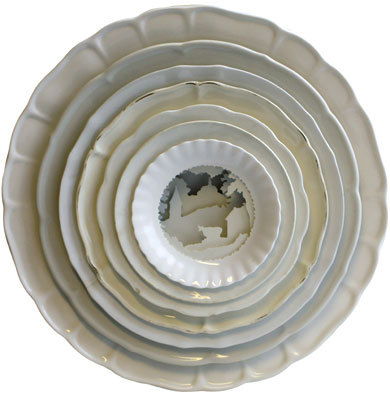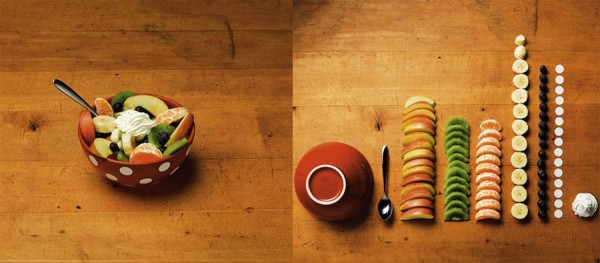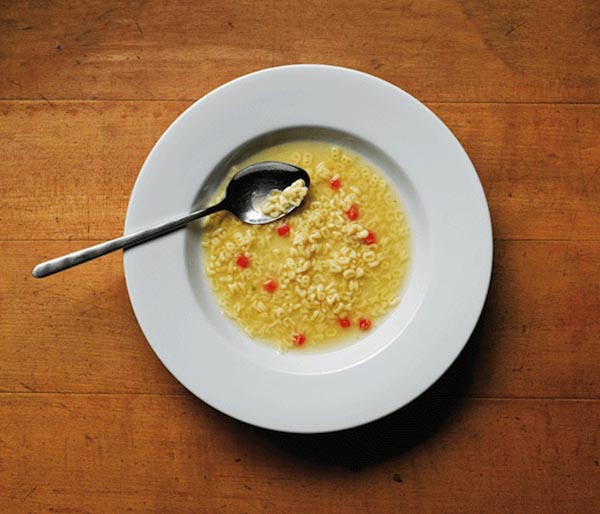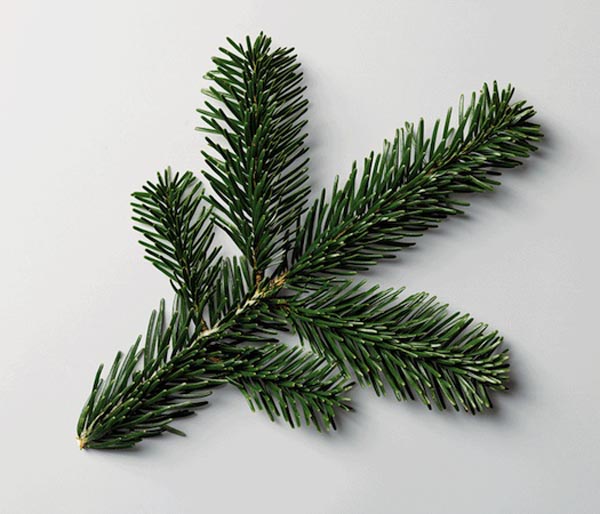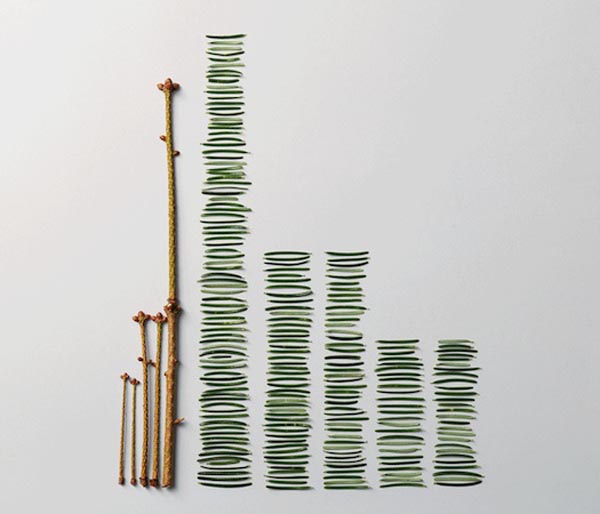12.16.2011
John Bauer
These works by John Bauer, a South African artist, are quite similar to what I have been experimenting with. I really love them, and strangely it makes me like my work more. It encourages me. The scale of these is magnificent - I have had so much more success working small with this idea, assuming he is knitting these then soaking them in slip. But, his goal is different than mine, though one that I can easily jump on board with. He wants to make the world fall in love with knitting again...beautiful.
Mary Rogers
Porcelain. Bowl with narrow foot, deep squashed bowl with 'deckled' edge. Rows of pierced holes beneath rim (27). Matt apricot and cream glaze
Porcelain. Flattened oval shape yellow/buff body. Decorated with pattern of grey/brown ovals under a white crackle glaze wich turns blue/green on ovals
Unique porcelain pinch built footed bowl with folded/frilled body and hand painted glaze decoration to interior, c. 1990.
Incised "MER"
Height 4 1/4" (10.5cm) Width 5" (12.5cm)
Interior view.
I wish this blog could make the noise these make me feel, but it cannot. Mary Rogers ceramic forms represent organic form and freedom. These works are absolutely gorgeous and delicate. I love the deckles edge and the holes in the first piece, the crackle glaze interacting with all that is beneath the surface, and the octopus looking innards of the third bowl. Her playfulness with symmetry is both engaging and appropriate for these porcelain forms.
Porcelain. Flattened oval shape yellow/buff body. Decorated with pattern of grey/brown ovals under a white crackle glaze wich turns blue/green on ovals
Unique porcelain pinch built footed bowl with folded/frilled body and hand painted glaze decoration to interior, c. 1990.
Incised "MER"
Height 4 1/4" (10.5cm) Width 5" (12.5cm)
Interior view.
I wish this blog could make the noise these make me feel, but it cannot. Mary Rogers ceramic forms represent organic form and freedom. These works are absolutely gorgeous and delicate. I love the deckles edge and the holes in the first piece, the crackle glaze interacting with all that is beneath the surface, and the octopus looking innards of the third bowl. Her playfulness with symmetry is both engaging and appropriate for these porcelain forms.
Kate Malone
Madame Bouquet Vase, 2006, 46 cm.
Pine Cone Box, 2004, 46 cm.
Spruecy Bean Pod, 2006, 43 cm.
Kate Malone incorporates elements from her every day life into her ceramic work. Her work is very sculptural and often times symmetrical. She uses positive symbolism in her work that is both playful and serious. She works in London primarily, but has smaller satellite studios in Barcelona and Provence...boy does that sound nice! She has a book titled "Kate Malone, A Book of Pots."
http://www.katemaloneceramics.com/about.html
Stephanie Syjuco
Stephanie Syjuco is a trickster. These works displayed were for her first solo show, at Catherine Clark Gallery, titled Raiders. She makes bold statements with her work. She gathers images of antique pottery and prints them at their original size, and then adheres to laser cut backings. These works are removed from their traditional context, function is distorted, gender roles questioned. She uses Asian pottery, questioning her heritage. She asks the question: who is the raider, the institution or the artist? Her concept is fascinating, and I think she pulled it off quite well.
http://www.stephaniesyjuco.com/cat_new.html
http://www.stephaniesyjuco.com/cat_new.html
Margrieta Jeltema
Margrieta Jeltema, who grew up in the Netherlands, creates forms that flow, are quite thin and appear to be translucent. It looks as though she uses slip to create these, maybe even a paperclay, or just super thin porcelain slabs. But I am not positive, and now I am quite curious! The photographs I have seen online of her work are just breathtaking - to see one of these in person would be magical. When lighted in a certain way, they glow. Most of her work has very little color and when it does, it is in harmony with the form. These works are incredibly elegant and feminine.
http://www.margrietajeltema.com/ceramics/
Maria Wojdat
Open (acid yellow)
Rounded (Sequence red to yellow)
Colour Lines
Maria Wojdat's work explores color, line and form, and the relationship between spontaneity and control. She received her bachelors in arts with honors in Graphic Design at the University of West England and her masters in Ceramic Design at Bath Spa University College in 2007, and since her work has popped up in many shows and publications. I wish I could see the bottom of just one of these, and I am curious as to whether they are heavy or not. These pieces are solid earthenware, with colored engobes sealed with wax.
http://www.mariawojdat.co.uk/index.html
Taizo Kuroda
No. 8
No. 14
No. 21
No. 22
No. 23
Japanese artist Taizo Kuroda's 'pure white' porcelain works are beautiful, and reflect his search for truth. In Japan, pottery is the most highly regarded of the arts. He uses fine grain sand paper to make his works smooth, and burnishes them, but does not use a glaze. This creates an eggshell like surface that is aesthetically pleasing, and I imagine the tactile experience would be marvelous as well. These forms are lovely, well balanced, and so incredibly thin, contrasting in No. 22 with the heavy foot. These works are all functional, but have a sculptural feel to them as well. Because of the incredible stylistic difference between them you couldn't tell by looking at his work that he has trained under the master Tatsuzo Shimaoka. I found this beautiful quote on his website: "A shape derives from the moment formlessness encounters form."
http://www.taizo-kuroda.com/profile.htm
Ron Nagle
Ron Nagle, The Mingler, 2003
Porcelain and glaze
3 2/3 x 5 1/2 inches
Courtesy Garth Clark Gallery
Ron Nagle, The Third Half, 2001
Earthenware
6 x 6 1/2 inches
Courtesy Garth Clark Gallery
Ron Nagle was born in San Fransisco, California in 1939. These works are very masculine, even seductive, and the control he had over the clay is incredible and flawless. As the geometry and form of these works are fascinating, the glazes he uses are what is most fascinating to me. Space is broken up by line and changes value, overarching form. He invests himself in these small works, and claims that they are more influenced by painting.
http://www.artlies.org/article.php?id=1424&issue=52&s=1
12.15.2011
Kjell Rylander
‘untitled’, 2007 (photo janne höglund)
‘circle’, 2000 (photo annci gustafsson)
‘untitled’, 2001 photo (janne höglund)
‘resistance’, 2001
Akershus Kunstnercenter 2003
http://www.kjellrylander.com/index.html
Caroline Slotte
From the series Rose Border Multiple, Double Blue II, reworked second hand object, 2007
Photo: Tuukka Paikkari
From the series Rose Border Multiple, Multiple Blue I, reworked second hand object, 2007
Photo: Tuukka Paikkari
From the series Rose Border Multiple, Blue & White (white), reworked second hand object, 2009
White Rose, reworked second hand object, 2003
Behind Pink Skies, reworked second hand object, 2006
These works are reworked second hand objects. I love the idea of upcycling, and I think she has pulled it off very well. These works are so beautiful. The depth created by cutting away parts of the plate and layering is so interesting, and I love that the function of the object is compromised by this process. I also love the color palette she sticks to, and I bet it would be a lot of fun to watch her process...acquiring the plates through hand me downs, thrift stores or estate sales, and then to see how she creates such a precise and smooth line. Fascinating!!
http://www.carolineslotte.com/works/works_2003_2006/8.html
Rebecca Wilson
These are from her series Finest Paperware. This work questions our throwaway culture. She builds this with cast sheets of specially formulated paperclay. These works are a derivative of traditional ceramics, "the ‘Jasperware’ version emulates Wedgewood’s iconic range using stained porcelain slip and embossed relief details in white. And the Dutch classic ‘Blue Delft’ is alluded to in digital decals scanned from hand drawn decals in blue biro." These really do look like paper cups, yet are much more beautiful and engaging. Maybe it's the gold varnish?
http://www.designboom.com/weblog/cat/10/view/15526/rebecca-wilson-finest-paperware.html
Bean Finneran
Drawing on aluminum black on white 1, 2010
gesso on aluminum panel
20" x 20"
Drawing on paper 1, 2010
paper, pencil and acrylic
Bean Finneran's work is awesome!Finneran was born in Cleveland, Ohio in 1947. She is very well educated, she has studied at Goucher College, University of Michigan, Museum School, Boston Museum of Fine Arts, and the Massachusetts College of Art.She has had many solo shows and group exhibitions. I love the movement the lines create in her work, and the way that her clay and two dimensional work correlate so well together.
http://pdxcontemporaryart.com/finneran
12.14.2011
Ursus Wehril
These works are from Swiss artist Ursus Wehril's project, "The Art of Clean Up," an upcoming book. He organizes things according to color, shape and size. He organizes meals to parking lots! I don't find it surprising that he is also a comedian. I find it so charming that he even took the polka dots off of the bowl that the fruit was in.
http://trendland.net/ursus-wehrlis-the-art-of-clean-up/
http://trendland.net/ursus-wehrlis-the-art-of-clean-up/
Subscribe to:
Posts (Atom)






























